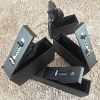I recently moved into a new house and am trying to create some good habits and put some procedures in place for myself and my wife regarding gun cleaning, transporting and storage around our home. In the meantime I’m trying to strike the balance between safety, security and accessibility, with safety obviously being the #1 priority.
For example, I have one room in my home that we clean and maintain our firearms in. Our procedure for cleaning after a range trip goes like this; all firearms and magazines are checked to ensure they are unloaded before they enter that room. No ammunition whatsoever is allowed in that room at any time, but regardless we check the room thoroughly for ammunition before bringing the unloaded firearms into the room. Before disassembly and before function checks we check individual firearms again. From here, the firearms we intend to keep empty go to our storage (soon-to-be gun safe) and the HD/SD firearms are loaded to their respective areas in which we keep them for quick accessibility.
I’m using this as an example to ask the question; have you instilled similar habits, levels of accountability or procedures for being safe with firearms inside your home that go beyond the 5 firearms safety rules? Do you have devices such as a clearing station, etc. to load your firearms or dry-fire? Do you have a place that you put your SD firearms whenever you get home?
For example, I have one room in my home that we clean and maintain our firearms in. Our procedure for cleaning after a range trip goes like this; all firearms and magazines are checked to ensure they are unloaded before they enter that room. No ammunition whatsoever is allowed in that room at any time, but regardless we check the room thoroughly for ammunition before bringing the unloaded firearms into the room. Before disassembly and before function checks we check individual firearms again. From here, the firearms we intend to keep empty go to our storage (soon-to-be gun safe) and the HD/SD firearms are loaded to their respective areas in which we keep them for quick accessibility.
I’m using this as an example to ask the question; have you instilled similar habits, levels of accountability or procedures for being safe with firearms inside your home that go beyond the 5 firearms safety rules? Do you have devices such as a clearing station, etc. to load your firearms or dry-fire? Do you have a place that you put your SD firearms whenever you get home?



